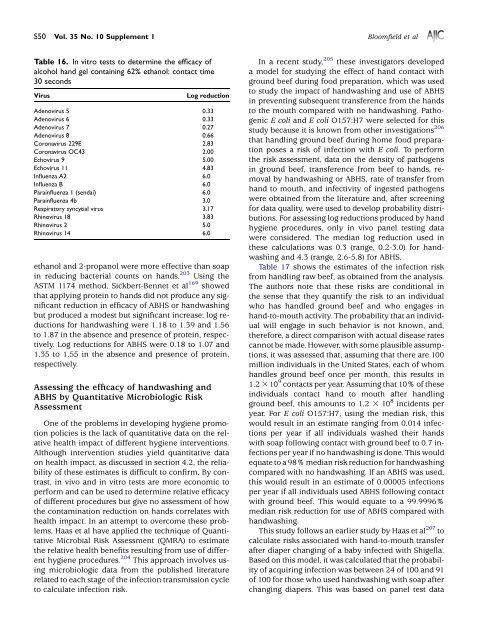The effectiveness of hand hygiene procedures in reducing the risks ...
The effectiveness of hand hygiene procedures in reducing the risks ...
The effectiveness of hand hygiene procedures in reducing the risks ...
You also want an ePaper? Increase the reach of your titles
YUMPU automatically turns print PDFs into web optimized ePapers that Google loves.
S50 Vol. 35 No. 10 Supplement 1 Bloomfield et alTable 16. In vitro tests to determ<strong>in</strong>e <strong>the</strong> efficacy <strong>of</strong>alcohol <strong>hand</strong> gel conta<strong>in</strong><strong>in</strong>g 62% ethanol: contact time30 secondsVirusLog reductionAdenovirus 5 0.33Adenovirus 6 0.33Adenovirus 7 0.27Adenovirus 8 0.66Coronavirus 229E 2.83Coronavirus OC43 2.00Echovirus 9 5.00Echovirus 11 4.83Influenza A2 6.0Influenza B 6.0Para<strong>in</strong>fluenza 1 (sendai) 6.0Para<strong>in</strong>fluenza 4b 3.0Respiratory syncytial virus 3.17Rh<strong>in</strong>ovirus 18 3.83Rh<strong>in</strong>ovirus 2 5.0Rh<strong>in</strong>ovirus 14 6.0ethanol and 2-propanol were more effective than soap<strong>in</strong> reduc<strong>in</strong>g bacterial counts on <strong>hand</strong>s. 203 Us<strong>in</strong>g <strong>the</strong>ASTM 1174 method, Sickbert-Bennet et al 169 showedthat apply<strong>in</strong>g prote<strong>in</strong> to <strong>hand</strong>s did not produce any significantreduction <strong>in</strong> efficacy <strong>of</strong> ABHS or <strong>hand</strong>wash<strong>in</strong>gbut produced a modest but significant <strong>in</strong>crease; log reductionsfor <strong>hand</strong>wash<strong>in</strong>g were 1.18 to 1.39 and 1.56to 1.87 <strong>in</strong> <strong>the</strong> absence and presence <strong>of</strong> prote<strong>in</strong>, respectively.Log reductions for ABHS were 0.18 to 1.07 and1.35 to 1.55 <strong>in</strong> <strong>the</strong> absence and presence <strong>of</strong> prote<strong>in</strong>,respectively.Assess<strong>in</strong>g <strong>the</strong> efficacy <strong>of</strong> <strong>hand</strong>wash<strong>in</strong>g andABHS by Quantitative Microbiologic RiskAssessmentOne <strong>of</strong> <strong>the</strong> problems <strong>in</strong> develop<strong>in</strong>g <strong>hygiene</strong> promotionpolicies is <strong>the</strong> lack <strong>of</strong> quantitative data on <strong>the</strong> relativehealth impact <strong>of</strong> different <strong>hygiene</strong> <strong>in</strong>terventions.Although <strong>in</strong>tervention studies yield quantitative dataon health impact, as discussed <strong>in</strong> section 4.2, <strong>the</strong> reliability<strong>of</strong> <strong>the</strong>se estimates is difficult to confirm. By contrast,<strong>in</strong> vivo and <strong>in</strong> vitro tests are more economic toperform and can be used to determ<strong>in</strong>e relative efficacy<strong>of</strong> different <strong>procedures</strong> but give no assessment <strong>of</strong> how<strong>the</strong> contam<strong>in</strong>ation reduction on <strong>hand</strong>s correlates withhealth impact. In an attempt to overcome <strong>the</strong>se problems,Haas et al have applied <strong>the</strong> technique <strong>of</strong> QuantitativeMicrobial Risk Assessment (QMRA) to estimate<strong>the</strong> relative health benefits result<strong>in</strong>g from use <strong>of</strong> different<strong>hygiene</strong> <strong>procedures</strong>. 204 This approach <strong>in</strong>volves us<strong>in</strong>gmicrobiologic data from <strong>the</strong> published literaturerelated to each stage <strong>of</strong> <strong>the</strong> <strong>in</strong>fection transmission cycleto calculate <strong>in</strong>fection risk.In a recent study, 205 <strong>the</strong>se <strong>in</strong>vestigators developeda model for study<strong>in</strong>g <strong>the</strong> effect <strong>of</strong> <strong>hand</strong> contact withground beef dur<strong>in</strong>g food preparation, which was usedto study <strong>the</strong> impact <strong>of</strong> <strong>hand</strong>wash<strong>in</strong>g and use <strong>of</strong> ABHS<strong>in</strong> prevent<strong>in</strong>g subsequent transference from <strong>the</strong> <strong>hand</strong>sto <strong>the</strong> mouth compared with no <strong>hand</strong>wash<strong>in</strong>g. PathogenicE coli and E coli O157:H7 were selected for thisstudy because it is known from o<strong>the</strong>r <strong>in</strong>vestigations 206that <strong>hand</strong>l<strong>in</strong>g ground beef dur<strong>in</strong>g home food preparationposes a risk <strong>of</strong> <strong>in</strong>fection with E coli. To perform<strong>the</strong> risk assessment, data on <strong>the</strong> density <strong>of</strong> pathogens<strong>in</strong> ground beef, transference from beef to <strong>hand</strong>s, removalby <strong>hand</strong>wash<strong>in</strong>g or ABHS, rate <strong>of</strong> transfer from<strong>hand</strong> to mouth, and <strong>in</strong>fectivity <strong>of</strong> <strong>in</strong>gested pathogenswere obta<strong>in</strong>ed from <strong>the</strong> literature and, after screen<strong>in</strong>gfor data quality, were used to develop probability distributions.For assess<strong>in</strong>g log reductions produced by <strong>hand</strong><strong>hygiene</strong> <strong>procedures</strong>, only <strong>in</strong> vivo panel test<strong>in</strong>g datawere considered. <strong>The</strong> median log reduction used <strong>in</strong><strong>the</strong>se calculations was 0.3 (range, 0.2-3.0) for <strong>hand</strong>wash<strong>in</strong>gand 4.3 (range, 2.6-5.8) for ABHS.Table 17 shows <strong>the</strong> estimates <strong>of</strong> <strong>the</strong> <strong>in</strong>fection riskfrom <strong>hand</strong>l<strong>in</strong>g raw beef, as obta<strong>in</strong>ed from <strong>the</strong> analysis.<strong>The</strong> authors note that <strong>the</strong>se <strong>risks</strong> are conditional <strong>in</strong><strong>the</strong> sense that <strong>the</strong>y quantify <strong>the</strong> risk to an <strong>in</strong>dividualwho has <strong>hand</strong>led ground beef and who engages <strong>in</strong><strong>hand</strong>-to-mouth activity. <strong>The</strong> probability that an <strong>in</strong>dividualwill engage <strong>in</strong> such behavior is not known, and,<strong>the</strong>refore, a direct comparison with actual disease ratescannot be made. However, with some plausible assumptions,it was assessed that, assum<strong>in</strong>g that <strong>the</strong>re are 100million <strong>in</strong>dividuals <strong>in</strong> <strong>the</strong> United States, each <strong>of</strong> whom<strong>hand</strong>les ground beef once per month, this results <strong>in</strong>1.2 3 10 9 contacts per year. Assum<strong>in</strong>g that 10% <strong>of</strong> <strong>the</strong>se<strong>in</strong>dividuals contact <strong>hand</strong> to mouth after <strong>hand</strong>l<strong>in</strong>gground beef, this amounts to 1.2 3 10 8 <strong>in</strong>cidents peryear. For E coli O157:H7, us<strong>in</strong>g <strong>the</strong> median risk, thiswould result <strong>in</strong> an estimate rang<strong>in</strong>g from 0.014 <strong>in</strong>fectionsper year if all <strong>in</strong>dividuals washed <strong>the</strong>ir <strong>hand</strong>swith soap follow<strong>in</strong>g contact with ground beef to 0.7 <strong>in</strong>fectionsper year if no <strong>hand</strong>wash<strong>in</strong>g is done. This wouldequate to a 98% median risk reduction for <strong>hand</strong>wash<strong>in</strong>gcompared with no <strong>hand</strong>wash<strong>in</strong>g. If an ABHS was used,this would result <strong>in</strong> an estimate <strong>of</strong> 0.00005 <strong>in</strong>fectionsper year if all <strong>in</strong>dividuals used ABHS follow<strong>in</strong>g contactwith ground beef. This would equate to a 99.9996%median risk reduction for use <strong>of</strong> ABHS compared with<strong>hand</strong>wash<strong>in</strong>g.This study follows an earlier study by Haas et al 207 tocalculate <strong>risks</strong> associated with <strong>hand</strong>-to-mouth transferafter diaper chang<strong>in</strong>g <strong>of</strong> a baby <strong>in</strong>fected with Shigella.Based on this model, it was calculated that <strong>the</strong> probability<strong>of</strong> acquir<strong>in</strong>g <strong>in</strong>fection was between 24 <strong>of</strong> 100 and 91<strong>of</strong> 100 for those who used <strong>hand</strong>wash<strong>in</strong>g with soap afterchang<strong>in</strong>g diapers. This was based on panel test data


